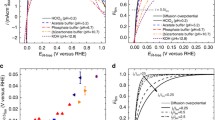Abstract
AT suitably activated palladium cathodes, the diffusion or hydride component of hydrogen Overpotential η2 (or ηd) can be separated conveniently from the total apparent Overpotential, η, by extrapolation of plots against time of changes in the open circuit potential, E, measured after cessation of electrolysis1–3.
Similar content being viewed by others
References
Clamroth, R., and Knorr, C. A., Z. Elektrochem., 57, 399 (1953).
Barton, J. C., and Lewis, F. A., Z. Physik. Chem. Neue Folge, 33, 99 (1962).
Green, J. A. S., and Lewis, F. A., Trans. Faraday Soc., 60, 2234 (1964).
Kandler, L., Knorr, C. A., and Schwitzer, C., Z. Physik. Chem. Lpz., A, 180, 281 (1937).
Fallon, R. J., and Castellan, G. W., J. Phys. Chem., 64, 4 (1960).
Author information
Authors and Affiliations
Rights and permissions
About this article
Cite this article
HULL, M., LEWIS, F. Diffusion or Hydride Component of Hydrogen Overpotential at Platinized Platinum and Palladized Palladium Cathodes. Nature 208, 887–888 (1965). https://doi.org/10.1038/208887a0
Issue Date:
DOI: https://doi.org/10.1038/208887a0
- Springer Nature Limited
This article is cited by
-
Effect of palladium on hydrogen charging of titanium cathodically polarized in acid media
Soviet Materials Science (1970)
-
Fluctuations of Overpotential during Electrolytic Evolution of Hydrogen
Nature (1967)





